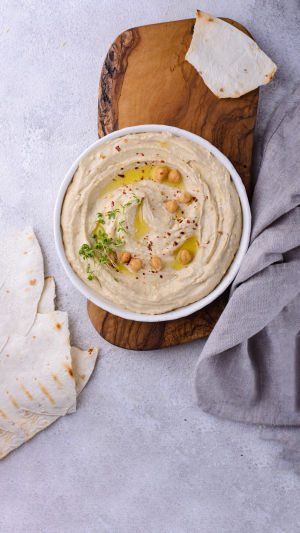Chickpeas rank as the world's third-largest bean variety, boasting exceptional nutritional value.
Abundant in 18 essential amino acids, proteins, dietary fiber, calcium, potassium, zinc, and various vitamins, chickpeas have earned the moniker "the flower of nutrition, the king of beans."
Despite the existence of numerous chickpea varieties, the distinctions in their nutritional profiles are relatively minor. This versatile legume is not only suitable for children, pregnant and nursing women but also for those aiming at weight loss, fitness, and the elderly.
Chickpeas, being low in starch, possess the dual benefit of regulating blood glucose and cholesterol levels. Moreover, they contribute to preventing constipation and rectal cancer.
Engaging in the creation of hummus, a cherished Middle Eastern dip, and spread, represents one of the most widely embraced applications for chickpeas.
Typically crafted by blending chickpeas, sesame paste, olive oil, lemon juice, and garlic, hummus stands out for its delicious taste and remarkable nutritional profile.
A 100-gram (3.5 oz) serving of hummus offers an impressive array of nutrients, including 166 calories, 9.6 grams of fat, 7.9 grams of protein, 14.3 grams of carbohydrates, and 6.0 grams of fiber.
Moreover, it acts as a significant reservoir of essential minerals, including manganese, copper, folic acid, magnesium, phosphorus, iron, zinc, thiamine, and vitamin B6, with potassium making up 7% of the recommended daily intake.
Beyond its rich nutrient content, hummus is recognized for its potential health benefits. Olive oil, a key ingredient, contains antioxidants with anti-inflammatory properties, comparable to common anti-inflammatory drugs.
Sesame seeds in hummus may aid in reducing inflammatory markers such as IL-6 and CRP. Scientific studies support the idea that incorporating legumes like chickpeas into one's diet can lower markers of inflammation.
The high fiber content of hummus contributes to digestive health by softening and increasing stool volume, promoting regular bowel movements.
Research indicates that adding chickpeas to the diet fosters the growth of beneficial bacteria like bifidobacteria while inhibiting harmful bacteria.
Moreover, hummus provides soluble fiber and healthy fats, slowing down carbohydrate digestion. The combination of fats further delays carbohydrate absorption in the gut, ensuring a gradual release of sugar into the bloodstream.
In comparison, studies have shown that hummus releases sugar into the bloodstream four times less than white bread despite offering the same amount of carbohydrates.
Chickpeas and hummus stand out not just for their delightful taste but also for the diverse nutritional advantages they bring, firmly establishing their position as a valuable inclusion in a wholesome and balanced diet.
The versatility of these legumes and their derived spread remains a focal point, capturing attention and highlighting a myriad of nutritional benefits.
Beyond their role in inflammation reduction, the olive oil found in hummus boasts antioxidants akin to anti-inflammatory medications, amplifying its health appeal.
The sesame paste's potential to decrease inflammatory markers, coupled with the legume's proven capacity to minimize blood markers of inflammation, reinforces the argument for integrating chickpeas into one's diet.
Furthermore, hummus emerges as a digestive ally, with its rich fiber content fostering gut health. The symbiotic relationship between chickpeas and beneficial gut bacteria underscores the holistic advantages of embracing these nutrient-packed delights.





